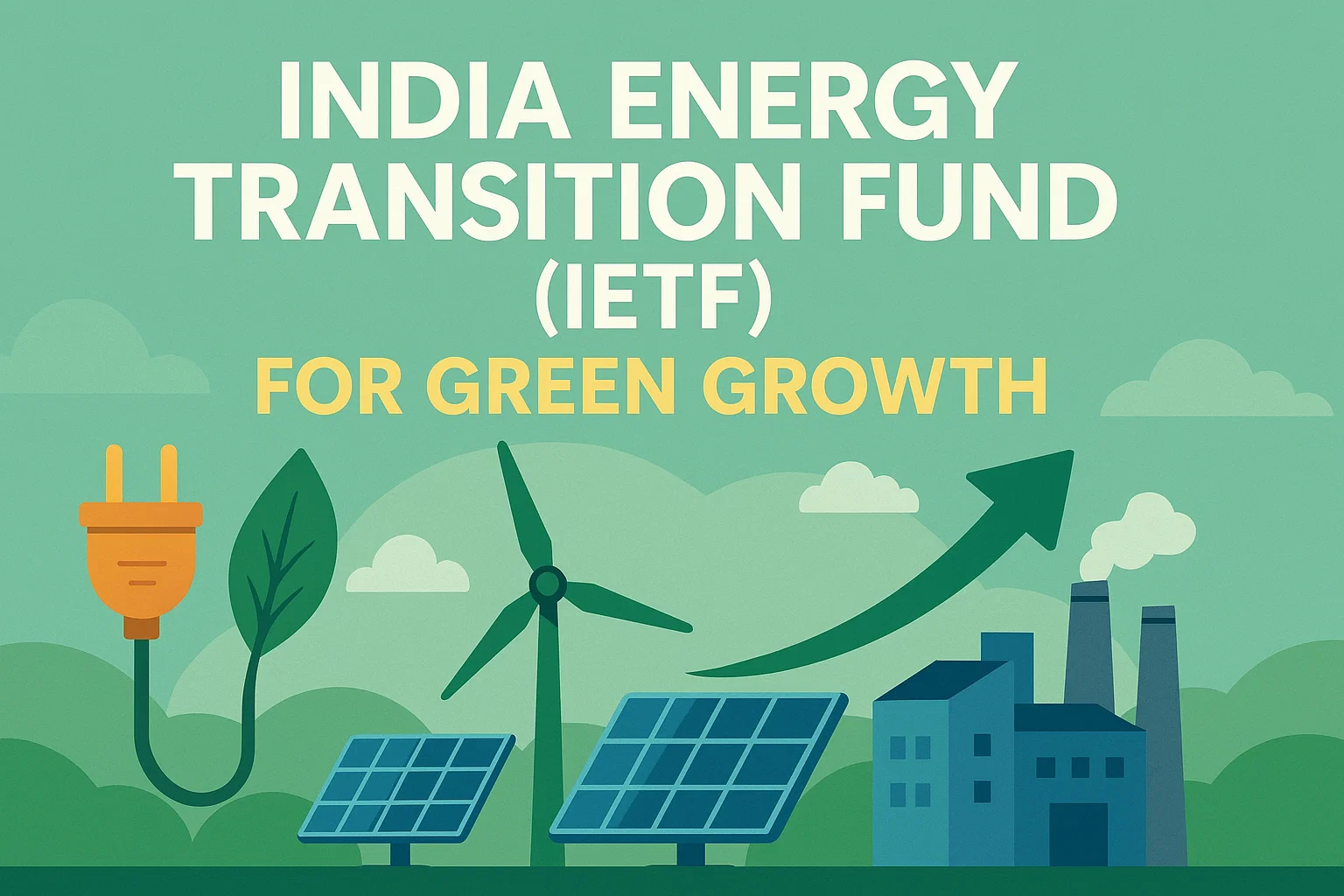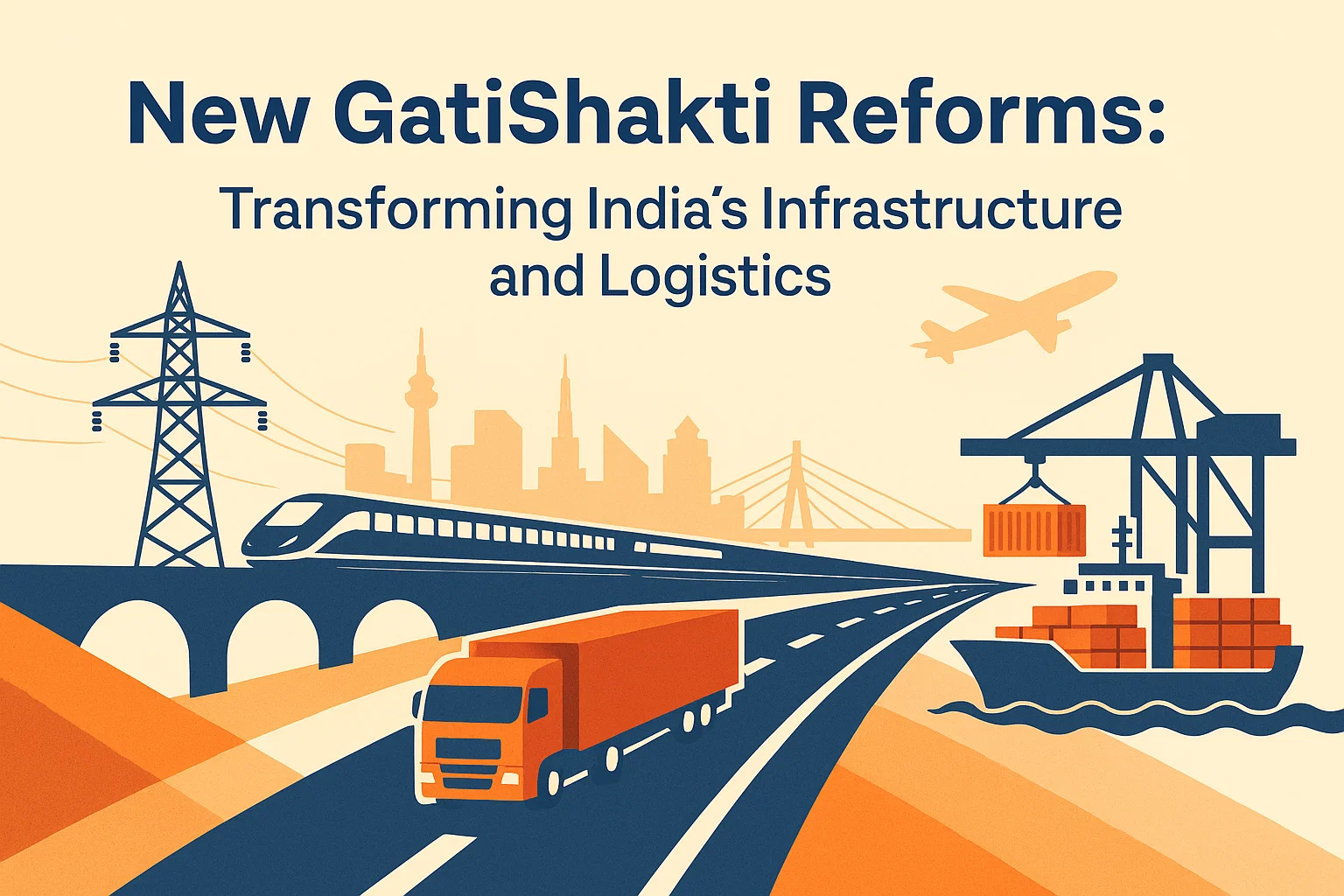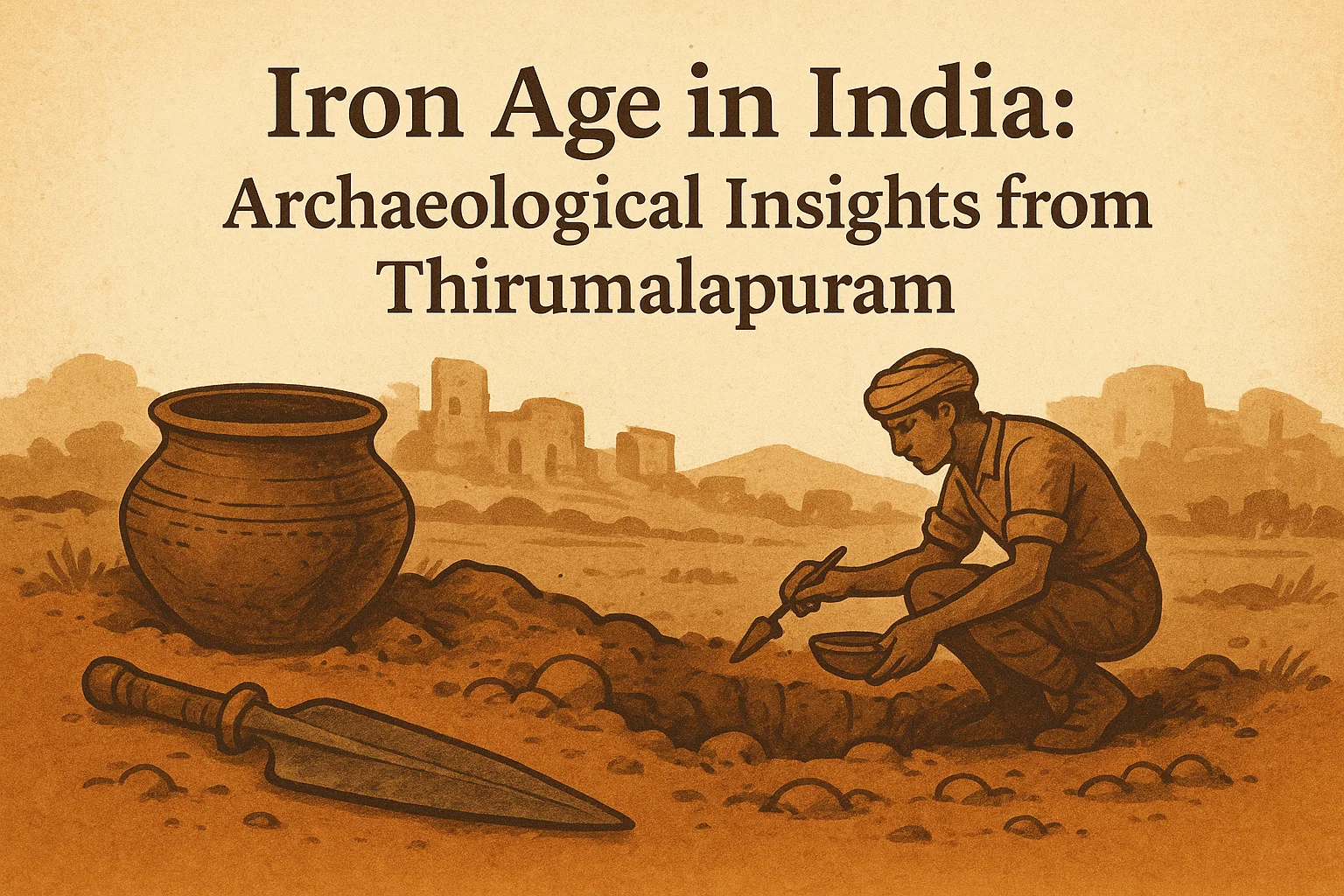Daily Current Affairs 11th July 2025
Welcome to today’s current affairs update, where we bring you key global and national developments in education, defence, diplomacy, finance, science, and biodiversity. From a national survey exposing learning gaps among students to the rise of optical atomic clocks and strategic shifts in global diplomacy, here are the major topics covered:
1) Countrywide survey reveals deficits in student learning
2) Rising Military Spending Risks Undermining Global Development Goals
3) Israel’s Persian Puzzle: A Costly Strategic Miscalculation
4) India’s Diplomacy Shows Strategic Strength Amid Global Conflicts
5) Catastrophe Bonds
6) Himachal Pradesh’s Leap in NAS 2025
7) The Rise of Optical Atomic Clocks
8) Species in News: Great Hornbill
Countrywide survey reveals deficits in student learning
Rising Military Spending Risks Undermining Global Development Goals
Context: The recent PARAKH Rashtriya Sarvekshan (formerly NAS) highlights Punjab, Himachal Pradesh, Kerala, Dadra & Nagar Haveli and Daman & Diu, and Chandigarh as the top-performing States and UTs in school education, reflecting strong implementation of learning outcome-based reforms.
What is the PARAKH RS Survey?
PARAKH RS stands for Performance Assessment, Review, and Analysis of Knowledge for Holistic Development Rashtriya Sarvekshen. It is a nationwide educational assessment framework under the National Education Policy (NEP) 2020, replacing the earlier National Achievement Survey (NAS).
-
- Conducted by: Ministry of Education, Government of India
- Coverage: 21,15,022 students from Grades 3, 6, and 9
- Sample: 74,229 schools across 781 districts
-
Subjects:
-
- Grades 3, 6 & 9: Language and Mathematics
- Grades 3 & 6: Environmental Studies (The World Around Us)
- Grade 9: Science and Social Science
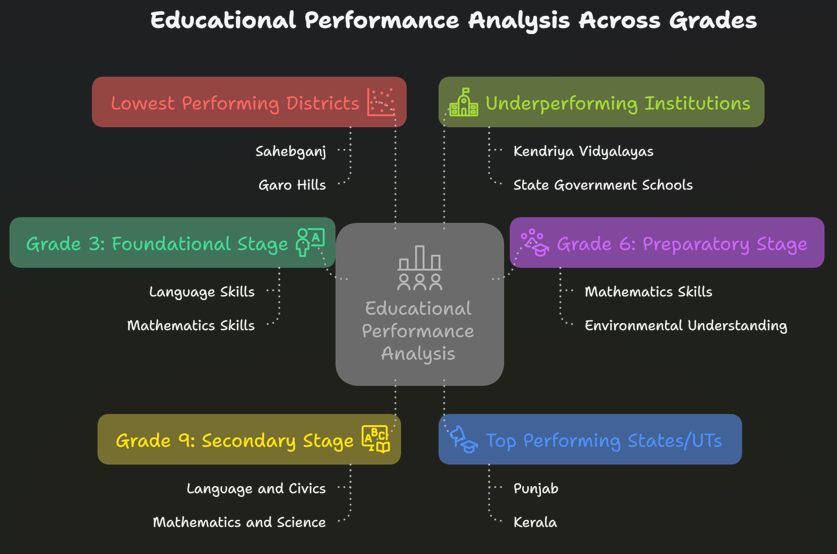
Why was the PARAKH RS survey conducted?
The primary goal of the survey was:
- To identify grade-level learning outcomes.
- To pinpoint deficiencies in foundational literacy and numeracy.
- To provide actionable feedback to policymakers for targeted reforms under NEP 2020.
It aligns with the NIPUN Bharat Mission, which aims to ensure that every child in India attains foundational literacy and numeracy (FLN) by the end of Grade 3.
When and how should corrective actions be taken?
- When?
- Immediately — The gaps start at the foundational stage and compound over time, causing underperformance in Grades 6 and 9.
- How?
- Short-Term:
- Use granular district-level data for targeted interventions.
- Integrate remedial classes during regular hours.
- Medium-Term:
- Align curriculum with competency-based assessments.
- Invest in teacher training with focus on FLN and pedagogical tools.
- Long-Term:
-
- Strengthen EdTech platforms like DIKSHA to personalize learning.
- Adopt adaptive assessments to track real-time learning outcomes.
-
- Government Initiative: NIPUN Bharat and PM SHRI Schools aim to integrate such reforms by 2026-27 for holistic foundational learning.
Rising Military Spending Risks Undermining Global Development Goals
What will be the effect of rising military spending?
Context: At the June NATO summit, member countries pledged to raise military spending from the previous 2% to 5% of GDP by 2035, covering core defence and related security expenditures. This reflects the sharp rise in global military spending driven by escalating geopolitical tensions.
What is driving the rise in global military spending in 2025?
- Geopolitical Conflicts: The NATO-Russia standoff, the Russia-Ukraine war, the Israel-Gaza and Israel-Iran conflicts, and the India-Pakistan military confrontation have intensified global insecurity.
- NATO’s New Target: At the NATO Summit in June 2025, member countries pledged to raise military spending to 5% of GDP by 2035, up from the previous 2% target.Fear and Strategic Posturing: NATO Secretary-General Mark Rutte justified the increase by saying, “We must spend more to prevent war,” citing the Russian threat, despite Russia’s economy being 25 times smaller than NATO’s combined economy.
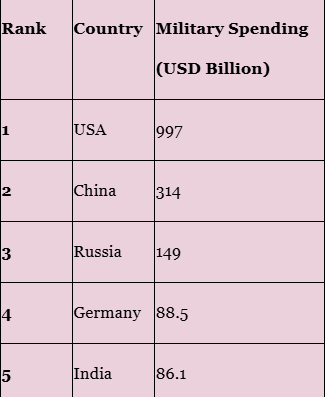
- According to SIPRI (2024), global military spending rose to $2.718 trillion, a 9.4% year-on-year increase, the highest since 1988.
Who are the biggest military spenders globally?
As per SIPRI 2024:
- NATO (32 countries) accounts for $1.5 trillion, about 55% of global spending.
- In GDP terms:
- Saudi Arabia: 7.3%
- Poland: 4.2%
- U.S.: 3.4%
- Spain, spending only 1.24% of GDP on defence, has opted out of the 5% NATO target, citing risks to welfare spending.
How does increased military spending affect domestic expenditure?
- Negative crowding-out effect: A study by Masako Ikegami and Zijian Wang across 116 countries finds a significant negative correlation between rising military spending and health expenditure, particularly in low- and middle-income countries.
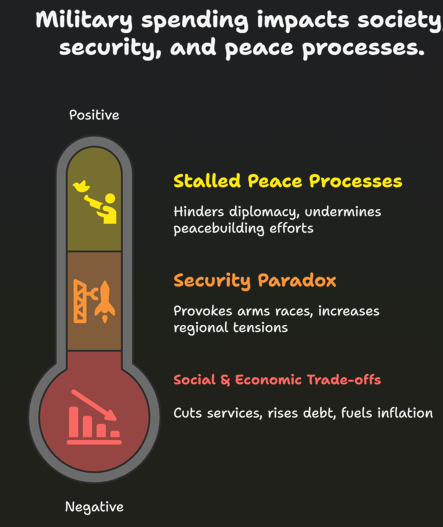
-
India’s case:
-
- Military spending: ₹6.81 lakh crore in 2024-25 + ₹50,000 crore emergency pos
- Health spending: Only 1.84% of GDP, far below the 2.5% target of the National Health Policy (2017).
-
Environmental costs of increased militarisation?
- A study by the Conflict and Environment Observatory highlights:
- If NATO reaches 3.5% GDP in defence spending, it will emit an additional 200 million tonnes of CO₂ annually.Militaries are among the largest institutional carbon polluters.
How is India being impacted by this remilitarisation wave?
- Spending Surge: Post-Operation Sindoor, India approved ₹50,000 crore for emergency defence purchases, atop its ₹6.81 lakh crore budget.
Why is the United Nations facing a funding crisis despite rising global expenditure?
- The UN’s development and humanitarian budget is dwarfed by military budgets:
- UN budget (2025): $44 billion (target), only $6 billion raised, prompting a cut to $29 billion.
- USAID (now shut down by Trump): Earlier contributed $50–60 billion annually to global aid.
Evidence from The Lancet Study: USAID aid prevented 91 million deaths (2000–2020). Its closure could result in 14 million more deaths by 2030, a third of them children.
- Health Trade-Off: With public health spending at only 1.84% of GDP, the imbalance is stark.
- Public Sentiment: Heightened nationalism and threat perceptions may push more budget towards militarisation..
Who benefits from the remilitarisation trend, and why is it concerning?
- Military-industrial complex: Gains from weapon production, arms trade, and defence contracts.
- Leadership narratives: Militarisation is often used to divert attention from domestic crises (e.g., Netanyahu’s strategy during the Gaza crisis).
Israel’s Persian Puzzle: A Costly Strategic Miscalculation
Israel has failed to solve the Persian puzzle
Context: In June 2025, Israel launched a high-stakes military operation targeting Iran’s nuclear infrastructure and military leadership, aiming to cripple Tehran’s strategic capabilities and possibly trigger regime change.
Who were the main actors involved in the conflict?
- Israel: Led by Prime Minister Benjamin Netanyahu, seeking to destroy Iran’s nuclear program and possibly initiate regime change.
- Iran: Led by the Islamic Revolutionary Guard Corps (IRGC) and Supreme Leader Ayatollah Khamenei, who retaliated with missile and drone attacks.
- United States: Under President Donald Trump, intervened by ordering air strikes on Iranian nuclear sites like Fordow.
- Non-State Actors: Iran-backed groups like Hezbollah were already weakened by Israeli offensives in prior months.
What triggered the Israel-Iran war in June 2025?
- The immediate trigger was Israel’s air strike on Iran on June 13, 2025, targeting Iran’s Natanz and Isfahan nuclear facilities, nuclear scientists, and top military commanders. This attack was the culmination of an escalatory trend that began after Hamas’s October 7, 2023 assault on Israel, which Israel blamed on Iran-backed support.
- Israel expanded its war from Gaza to Hezbollah in Lebanon and Iranian proxies in Syria, including bombing the Iranian embassy in Damascus in April 2024, before taking direct aim at Iran itself.
What was Israel’s strategic goal?
Israel’s ultimate objective was regime change in Iran and the permanent destruction of its nuclear capabilities. Netanyahu’s rhetoric during the war suggested that Iran was “very weak” and urged Iranians to rise against their government.
Strategic rationale:
- Eliminate Iran as the last major conventional threat in West Asia.
- Replicate Israel’s past preemptive strike success, especially the 1967 Six-Day War.
- Establish an uncontested Israeli-American regional hegemony.
What were the key operational outcomes of the war?
- Operational Success: Israel assassinated 30 Iranian security chiefs and at least 10 nuclear scientists.
- Struck deep targets inside Iran (~2,000 km away), including Natanz and Isfahan.
- U.S. air strikes targeted Fordow, one of Iran’s most fortified nuclear facilities.
- Strategic Failure:
- Iran’s regime remained intact.
- Iran launched successful retaliatory strikes using drones and ballistic missiles.
- Iran’s nuclear program was delayed, not destroyed — reports said only a few months’ setback.
Why didn’t the Israeli-American operation achieve strategic success?
Despite the precision and depth of the operation, the key reasons for failure include:
- Resilience of the Iranian regime: The IRGC quickly reorganised and coordinated retaliatory strikes.
- Inability to destroy dispersed nuclear assets: European intelligence and IAEA reports noted Iran had dispersed enriched uranium before the strike.
- Over-reliance on U.S. military support: Unlike the 1967 war, Israel could not operate autonomously at strategic depth.
How did Iran respond to the attack?
- Iran launched a sustained missile and drone offensive on Israel, exposing the vulnerabilities in Israel’s multi-layered air defence system. The Iranian leadership framed the attack as another “Mosaddegh moment,” recalling the 1953 CIA coup as proof of Western duplicity.
- This reinforced Tehran’s internal consensus that nuclear weapons are essential for deterrence, just as North Korea’s arsenal deters U.S. aggression.
What was the role of the United States in the conflict?
The U.S., under President Donald Trump, intervened only after Israel’s initial strike faced retaliation. On June 21, Trump ordered limited air strikes on Iranian nuclear facilities but refused to prolong U.S. involvement.
Reasons for U.S. caution:
- Trump’s MAGA voter base opposed entanglement in another West Asia war.
- Washington wanted to cripple Iran’s nuclear program but not trigger regional destabilisation or an oil crisis.
How has the war affected Iran’s nuclear program?
According to U.S. intelligence and the IAEA, the war caused only a temporary setback:
- Iran can rebuild enrichment capacity within months.
- Highly enriched uranium and centrifuges were not fully destroyed.
- Iran now has stronger domestic motivation to pursue nuclear weapons as an ultimate deterrent.
- Iran is a signatory of the NPT (Non-Proliferation Treaty) but has repeatedly defied inspection protocols since the U.S. exited the JCPOA in 2018.
- As per IAEA Director Rafael Grossi, Iran’s technical infrastructure remains intact for rapid nuclear restoration.
What does this mean for West Asian geopolitics?
- Israel’s image of military invincibility is weakened — its defence systems faltered under Iran’s missile onslaught.
- The war re-affirmed the strategic autonomy of Iran, despite its economic and military constraints.
- The region remains volatile, with both sides now preparing for the next round:
- Israel remains paranoid and more reliant on international support.
- Iran is accelerating military recovery and deterrence building, potentially including nuclear weapons.
What lessons does this conflict offer for international security?
- Deterrence still works — when it’s nuclear: Iran’s lack of a nuclear deterrent may have invited aggression, unlike North Korea, which is left untouched.
- Regime change is not a guaranteed outcome: The failure to topple Iran echoes U.S. failures in Iraq, Libya, and Afghanistan, where militarised regime change backfired.
- War has escalatory limits in a nuclear environment: Even superpowers like the U.S. chose restraint to avoid long-term quagmire and regional destabilisation.
How does this connect to India’s strategic thinking?
- The conflict could disrupt energy security — Iran is a major oil supplier and lies on the Strait of Hormuz, a chokepoint for 40% of global oil.
- India must reinforce strategic autonomy — avoid alignment in conflicts involving great powers.
- The episode strengthens the case for nuclear deterrence as a shield, a principle India adopts through its No First Use policy.
India’s Diplomacy Shows Strategic Strength Amid Global Conflicts
India’s diplomacy is measured, not mute
Context: On June 13, amid its ongoing war with Hamas, Israel launched strikes on Iranian targets across multiple provinces, escalating tensions in an already volatile West Asia. The conflict lasted 12 days. India responded with restraint, calling for de-escalation and peace.
What was the nature of the Israel-Iran conflict in June 2025?
- Background of the Conflict: On June 13, 2025, Israel launched airstrikes on Iranian targets across several provinces, intensifying tensions in the already volatile West Asian region. The 12-day confrontation occurred while Israel was still engaged in warfare with Hamas in Gaza.
- Significance: This conflict represents a major flashpoint in West Asia, where geopolitical rivalries, proxy warfare, and nuclear threats are tightly interwoven. Iran and Israel have long been engaged in a shadow war involving cyberattacks, covert operations, and regional alliances.
How did India respond to the Israel-Iran conflict?
-
- India’s Position: India maintained a cautious and balanced diplomatic stance, calling for “restraint and de-escalation” and reaffirming that this is “not an era of war.”
-
Key Actions:
-
- Evacuation of Citizens: Through Operation Sindhu, India swiftly evacuated its nationals, primarily students, from both Israel and Iran.
- Humanitarian Aid: India has provided aid in previous West Asian conflicts, reinforcing its humanitarian commitments.
- UN Engagement: India supported a UN General Assembly resolution for a permanent ceasefire in Gaza, underlining its consistent push for peace.
Why does India prefer a neutral and measured approach in West Asia?
- Strategic Interests in West Asia:
-
- Defence Ties with Israel: Includes co-development of defence technologies and purchase of surveillance drones and missiles.
- Energy & Trade Ties with Iran: India has historically imported crude oil from Iran and has stakes in the Chabahar Port, a strategic gateway to Central Asia.
- Diaspora Concerns: Over 9 million Indians reside in the Gulf, contributing to $100+ billion in remittances (RBI, 2024).
- Diplomatic Rationale:
- Jeopardise economic ties.
- Expose diaspora to retaliatory risk.
- Undermine India’s aspiration for strategic autonomy.
Who benefits from India’s current foreign policy strategy?
- Domestic Stakeholders:
-
- Indian citizens in conflict zones benefit from timely evacuations.
- Indian businesses secure market access in the Gulf and West Asia.
- International Perception: India is increasingly seen as a credible neutral power capable of engaging with diverse and often rival nations (e.g., Israel, Iran, UAE, Saudi Arabia).
When has India previously adopted such cautious diplomacy?
- Russia-Ukraine War (2022–ongoing): India abstained from UN votes against Russia while consistently calling for peace and supplying humanitarian aid to Ukraine.
- Saudi-Iran Rivalry: India maintained working ties with both Riyadh and Tehran despite their animosity, balancing pilgrim access, oil imports, and strategic infrastructure.
Policy Continuity: India’s Non-Alignment 2.0 posture – updated for 21st-century geopolitics – forms the backbone of its diplomacy.
Where does India’s stand diverge from Western and Arab expectations?
- Western Powers:
- Arab States:
-
- Though expanding economic ties with India, many remain bound by religious solidarity with Pakistan or the Palestinian cause.
- Often question India’s growing ties with Israel.
India’s Response: India continues strategic engagement on all sides without succumbing to bloc-based pressure or moralistic narratives. Its “multi-alignment” strategy places national interest above ideological alignment.
How does India’s approach reflect its broader foreign policy doctrine?
- Key Doctrinal Pillars:
-
-
- Strategic Autonomy: India will not be pressured into alignment by the West, China, or Islamic blocs.
- Multi-Engagement: Maintaining simultaneous relations with adversarial states.
- Economic Diplomacy: Trade, investment, and connectivity are central.
-
- Institutional Backing: India’s Foreign Policy Strategy Documents (MEI, 2023) emphasise national security, global south solidarity, and multipolarity.
Catastrophe Bonds
How can cat bonds plan for a natural disaster?

Context: India is considering catastrophe bonds to boost disaster risk financing and climate resilience amid increasing natural disasters.
India, ranked third globally in natural disasters since 1900 (after the US and China), faces a huge protection gap, with only 8-10% of losses insured compared to the global average of 54%. Recent disasters like the Wayanad landslide (July 2024, 350+ deaths) and recurring floods in Kerala, Himachal Pradesh, and Uttarakhand highlight the urgent need for a robust catastrophe insurance mechanism. Despite proposals like the National Catastrophe Insurance Pool (INCIP) and catastrophe bonds (CAT bonds), India still lacks a structured disaster risk financing system.
What is a Cat Bond?
- Cat bonds are hybrid insurance-debt instruments that convert insurance coverage into tradable securities.
- They transfer disaster risk from governments or insurers to global financial markets, ensuring faster payouts and reducing counterparty risk.
- Unlike traditional insurance, cat bonds securitise risk, allowing investors to bear the loss in exchange for higher coupon rates.
How Do Cat Bonds Work?
- Sponsors: Sovereign nations or insurers issue cat bonds, paying premiums to investors.
- Intermediaries: Institutions like the World Bank, Asian Development Bank, or reinsurers help structure and issue these bonds.
- Trigger Mechanism: If a pre-defined disaster (e.g., earthquake, cyclone) occurs, investors may lose part of their principal, which is used for relief and reconstruction.
- Coupon Rates: Vary based on risk—earthquake bonds may offer 1-2%, while hurricane bonds command higher premiums.
Why Are Cat Bonds Profitable for Investors?
- Risk Diversification: Cat bonds are uncorrelated with financial markets, making them attractive for pension funds, hedge funds, and family offices.
- Higher Returns: Due to the risk of principal loss, cat bonds offer better yields than conventional debt instruments.
- Market Growth: Since the 1990s, $180 billion in cat bonds have been issued globally, with $50 billion still active.
Does India Need Cat Bonds?
- Increasing Disaster Risks: Climate change has intensified cyclones, floods, and earthquakes in South Asia, making traditional insurance costly.
- Financial Protection: Cat bonds can ring-fence public finances, ensuring funds for reconstruction without straining budgets.
- Cost-Effectiveness: India’s strong credit rating and existing risk mitigation programs (e.g., $1.8 billion/year allocated since FY21-22) make it a viable candidate.
- Regional Leadership: India could lead a South Asian cat bond, pooling risks for earthquakes (Bhutan, Nepal, India) or cyclones (India, Bangladesh, Sri Lanka).
What Are the Challenges of Cat Bonds?
- Design Risks: Poorly structured bonds may not trigger payouts even in severe disasters (e.g., a 6.5M earthquake vs. a 6.6M threshold).
- Cost Concerns: If no disaster occurs, governments may face scrutiny over premium expenses.
- Transparency Needed: Premiums should be compared with historical disaster costs to ensure fiscal prudence.
The Way Forward for India
- Adopt Cat Bonds: Partner with World Bank or ADB to issue India-specific or regional cat bonds.
- Strengthen Risk Mitigation: Continue investing in disaster preparedness to lower premiums.
- Explore Multi-Country Bonds: A South Asian cat bond could reduce costs and enhance regional resilience.
Himachal Pradesh’s Leap in NAS 2025
How did Himachal achieve a high rank on the NAS?
Context: The National Achievement Survey (NAS) 2025 results revealed Himachal Pradesh’s remarkable 16-rank jump—from 21st position in 2021 to top 5—while Punjab and Kerala retained their lead. This turnaround highlights the state’s revived public education system after years of decline.
What Changed Recently?
- School mergers: Over 1,000 under-enrolled schools merged to optimise resources.
- Unified education system: Single directorate from pre-primary to Class 12.
- Empowered local decision-making: Boosted student ownership and school identity.
- Exposure opportunities: National and international visits for teachers and top students.
- Cluster-based school management: Promoted peer learning, resource sharing, and community engagement.
What is the National Achievement Survey (NAS)?
-
- Conducted by: Ministry of Education, Government of India
- Frequency: Every three years
- Purpose: Measures learning outcomes of students in government and government-aided schools
- Grades Assessed: Classes 3, 5, 8, and 10
- Subjects Covered: Language, Mathematics, Environmental Science, Science, and Social Science
- Use: Provides States with diagnostic data to inform educational policy and planning
- Limitations: Focuses only on measurable academic outcomes. Broader educational goals — such as critical thinking, emotional well-being, civic values, and social equity — lie outside its scope.
What Lies Ahead for Himachal Pradesh?
- While the recent results are encouraging, they are just the beginning. For Himachal Pradesh to build on this momentum, it must:
- Regularise teacher appointments to provide stability.
- Expand assessment frameworks to include holistic, formative indicators.
- Ensure inclusive education, particularly for rural and marginalised students.
- Maintain focus on community involvement and teacher development.
The Rise of Optical Atomic Clocks
Intercontinental optical clock comparison sets stage to redefine the second
Context: A global team of scientists has completed the largest and most demanding comparison of atomic clocks in history, advancing efforts to redefine the SI unit of time: the second. The new study involved 10 advanced optical atomic clocks across three continents, and results could help establish a new global time standard by 2030.
What is the Second — and Why Redefine It?
- Current Definition of the Second: The SI unit of time, the second, is currently defined by caesium (Cs) atomic clocks.
- Definition (1967): “The duration of 9,192,631,770 periods of the radiation corresponding to the transition between the two hyperfine levels of the ground state of the caesium-133 atom.”
- This definition is based on microwave frequency radiation emitted by Cs atoms.
- Limitations and Need for Redefinition: Cs clocks drift by one second in 300 million years — accurate, but not sufficient for emerging ultra-precise applications. New technologies like GPS, climate science, and radio astronomy demand clocks with greater stability and precision.
- Optical atomic clocks are the next step, capable of enumerating one second up to 18 decimal places.
Optical Clocks: The Next Frontier
- Unlike Cs clocks operating in the microwave range, optical clocks function using frequencies in the optical spectrum, which are around 10,000 times higher. For example:
- A strontium (Sr) atom emits radiation at 429 trillion Hz
- A ytterbium (Yb⁺) ion emits at 642 trillion Hz
- These frequencies allow optical clocks to measure time so precisely that some drift less than one second in 15 billion years—longer than the age of the universe.
The Big Test: Comparing Clocks Worldwide
- 65 researchers from national labs in Finland, France, Germany, Italy, the U.K., and Japan compared 10 optical atomic clocks based on five different atoms and ions: Strontium-87 (Sr), Ytterbium-171 (Yb), Charged ytterbium ions in two states (Yb⁺ E2 and Yb⁺ E3), Charged strontium-88 (Sr⁺), Indium-115 ions (In⁺).
- These clocks were connected using a mix of:
- Optical fibres (for clocks in close proximity)
- Telecom networks with amplifiers (for continental links)
- High-precision GPS techniques, especially Integer Precise Point Positioning (IPPP), for overseas links
- To maintain continuity during clock downtime, backup clocks using GPS data filled in, handing control back once the primary clocks resumed.
Key Findings:
- The comparison generated 38 independent optical frequency ratios, including four never measured before. The tightest result had an uncertainty of just 4.4 × 10⁻¹⁸, showing unprecedented precision.
- Most clocks matched within 10⁻¹⁶ to 10⁻¹⁸, validating the global coherence of optical clock standards. For example:
- Strontium clocks in France and Germany differed by less than 2 × 10⁻¹⁶
- The U.K. and Germany’s clocks, connected via GPS, agreed within 3 × 10⁻¹⁶
Challenges Identified
- Discrepancy at Italian Yb clock: GPS measurements were off by 4 × 10⁻¹⁶ compared to fibre readings — revealing a signal glitch.
- Small shifts in France-Germany Sr clocks: Offsets up to 2 × 10⁻¹⁶ were noted, which matter at extreme precision and need deeper investigation.
Implications and Future Outlook
- India’s Contribution to Timekeeping: India’s National Physical Laboratory (New Delhi) maintains five Cs atomic clocks. Disseminates time data across the nation using INSAT satellites, telecom, and fibre networks.
- This multinational test demonstrated that optical clocks on different continents could agree to 10⁻¹⁶ – 10⁻¹⁸ precision. Uncovered critical issues to address before the global redefinition of the SI second, expected around 2030.
Species in News: Great Hornbill
Rare Great Hornbill sighting in Ezhimala sparks hope for biodiversity
Context: The Malamuzhakki Vezhambal (Great Hornbill), Kerala’s State Bird, was spotted in Kakkampara, near Ezhimala in Kannur, far from its usual forest habitat.

About Great Hornbill:
- Scientific Name: Buceros bicornis
- Common names: Concave-casqued hornbill, great Indian hornbill, or great pied hornbill.
- The Great Hornbill is the State Bird of Kerala.
- A large bird from the family Bucerotidae, recognised by its long, curved beak topped with a casque — a hollow bony structure.
- Physical Characteristics:
-
- They are large, vividly colored birds measuring 95–120 cm in length with a wingspan of 151–178 cm and weighing around 3 kg.
- They have a black body and wings, a white neck and abdomen, and a white tail with a black band. A preen gland near the tail secretes tinted oil, giving parts of the body a yellow to red hue.
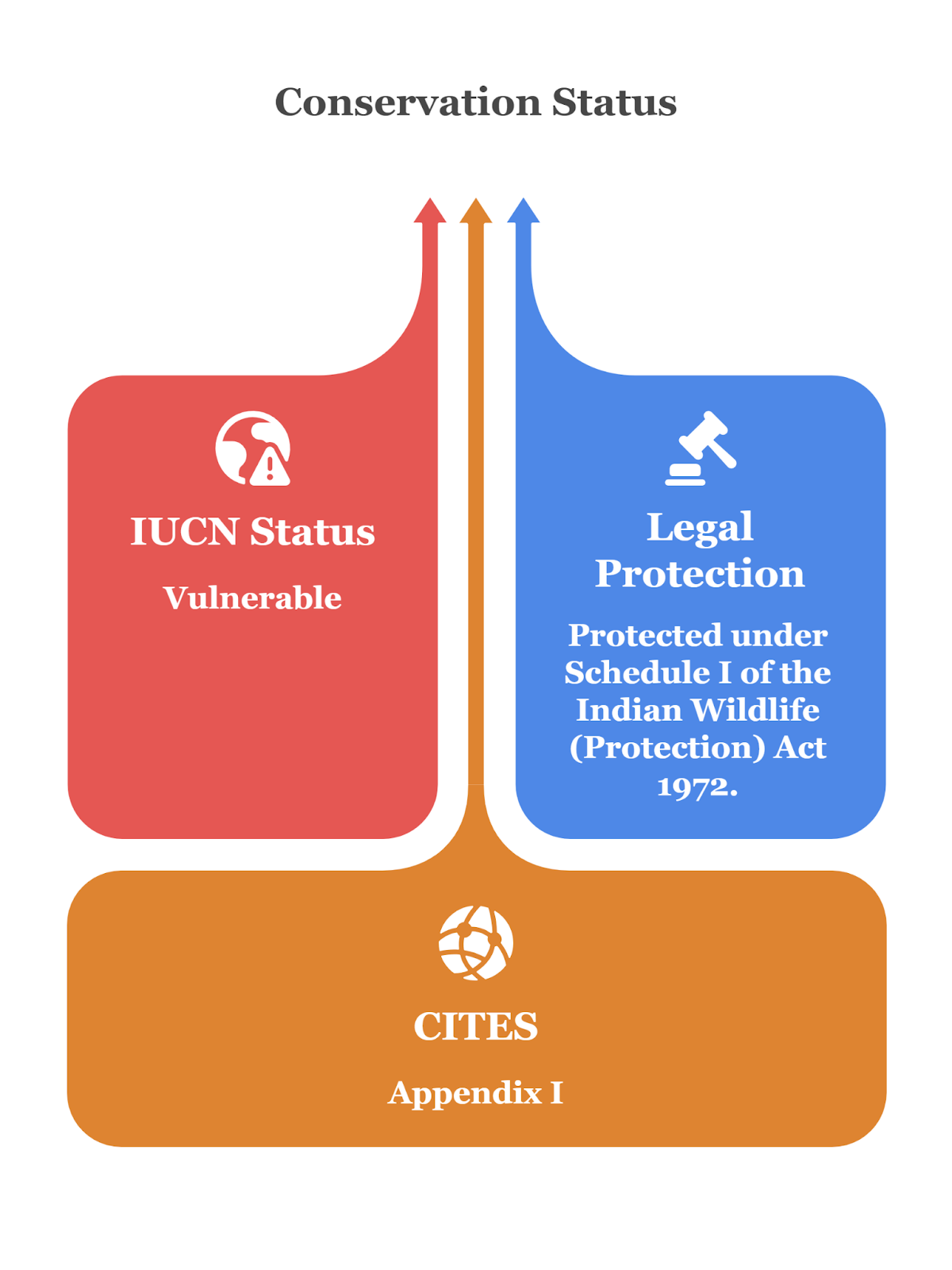
- Distribution: It is found across mainland Southeast Asia, the Malay Peninsula, and Indonesia, with breeding populations in countries like India, Bhutan, Nepal, and others.
- In India, it inhabits the Western Ghats, evergreen and moist deciduous forests of the northeastern and southern regions.
- Diet: Primarily frugivorous, feeding on both lipid- and sugar-rich fruits, especially from nutmeg trees (Knema, Myristica) and Lauraceae species like Beilschmiedia.
- The species is hunted occasionally for its meat, feathers, and ornamental casque, used in rituals or traditional medicine. Despite these threats, it plays a crucial ecological role as a key seed disperser, aiding forest regeneration.
Subscribe to our Youtube Channel for more Valuable Content – TheStudyias
Download the App to Subscribe to our Courses – Thestudyias
The Source’s Authority and Ownership of the Article is Claimed By THE STUDY IAS BY MANIKANT SINGH



